Located right in the middle of Central America, Honduras has plenty of different touristic sites for varied interests. From archaeological sites and towns with colonial buildings to almost a quarter of territory turned into protected areas for nature lovers, beautiful beaches spanning over 500 miles of its Caribbean North coast and crystal-clear warm water coupled with bleached sand beaches at the Bay Islands, a section of the Mesoamerican barrier reef, second largest of its kind in the world and first in biodiversity; living cultures that bear ancient traditions and authentic cultural heritage, and certainly the friendliest people in the region.
1. Copan
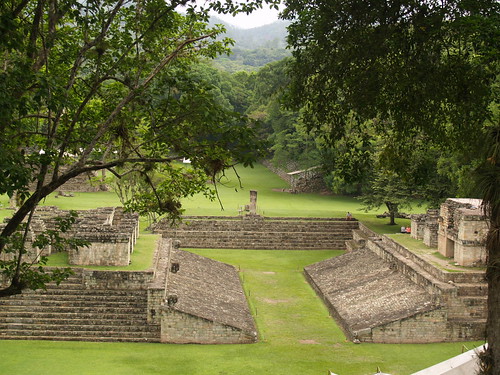 |
| Ball Court and Main Plaza, Copan Ruinas |
The southernmost Maya city–state of Copan flourished during a major Classic period from the 5th to 9th centuries AD, when Maya art and science development reached its peak just before mysteriously vanishing. You can enjoy a one-hour easy walk through the park, preferably with a local Tour Guide who will let you deep into the story of this fascinating place.
The Maya Sculpture Museum is one of the best in the region, holding the highest detail in original pieces found in the site protecting them from the elements as well as a full size replica of the Rosalila Temple, discovered in the late 80s, one of the intact temples preserved underneath one of the structures in the main site.
Besides the archaeological park, Copan has plenty of activities to keep you busy for a couple more days. There is the Copan Coffee Tour, a nice hike through shade grown coffee plantations under huge elderly trees inside an authentic primary rainforest just a 30-minute drive from town. Here you can learn about the harvesting and processing of this known bean variety that has become a key to most of our lifestyles.
At the Macaw Mountain Bird Park Reserve you will watch over 200 birds from different species such as macaws, parrots, toucans, owls, and hawks; some are flying freely in the park while others are kept inside spacious aviaries, and you can even have an encounter with some lucky ones at the interaction area. Most of these birds have been rescued from smugglers or donated from people who had them as pets, and since they were not able to survive alone in the wild, they are taken care of in the park.
The Luna Jaguar Hot Springs and Spa 50 minutes from town provides all necessary elements for a relaxing afternoon soothing your body, and for the more active people there is the Los Sapos Canopy Tour with 14 zip-lines (one of them over half a mile long and 650 feet above the ground) qualified by some people as one of the best in Central America.
2. Roatan and Utila
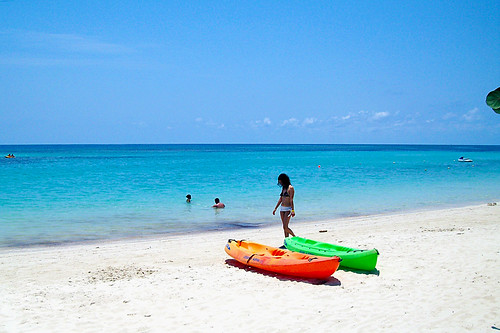 |
| West Bay Beach at Roatan, Bay Islands |
The Gumbalimba Natural Park has a zip-line, a jungle with a lagoon and an interaction area with monkeys and macaws, a nice hanging bridge and water sports, all available to spend a nice full day of fun and adventure. You can also visit a nice cameo factory, where you can see the ancient delicate art of carving mythical images in sea shells. There is also an iguana farm, glass bottom boat tours and dolphin encounters available for you.
Utila, the smallest of the Bay Islands is a true heaven for divers, it is the less expensive place in the planet to get PADI certification, a preferred spot for the impressively giant whale shark and plenty of marine life, still a truly enjoyable paradise not crowded at all.
3. Tela
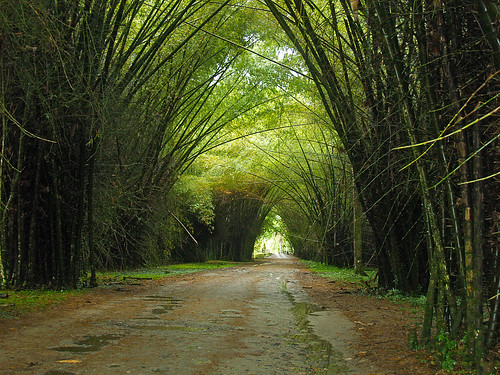 |
| Lancetilla Botanical Garden, Tela |
There are nice fully appointed resorts to enjoy some sunny days, and there are also four different protected areas in the surroundings: Jeannette Kawas National Park; accessible only by water, this park has some of the nicest beaches around and totally off the beaten path to have them only for you, there is plenty of wildlife to be seen such as howler, white-faced, and spider monkeys, alligators, many aquatic birds and (if you are lucky) some dolphins along the boat on the way in. Los Micos Lagoon is a place to go on a motor boat right past the Garifuna village of Miami where you can visit a Garifuna Museum and interact with the ethnic locals during their daily life.
Tela is also home to the Lancetilla Botanical Garden, the second largest botanical garden in the world, holding a wide variety of plants and trees from around the globe. This garden was built as a research facility by one of the banana companies and is now maintained by the government. The Punta Izopo Wildlife Reserve is an intricate maze of mangroves where you can kayak along to enjoy the peace of this remote area while watching some abundant wild life.
4. La Ceiba
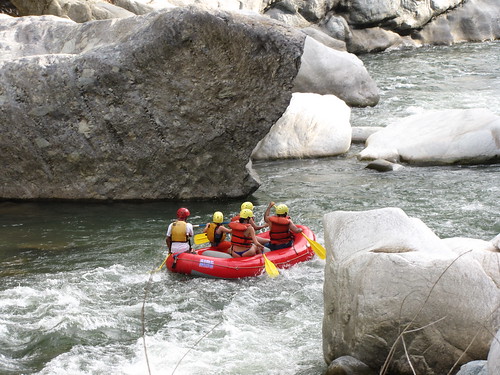 |
| Cangrejal River Rafting, La Ceiba |
Cuero y Salado Wild Life Refuge is a coastal manatee and wildlife refuge where the Cuero and Salado Rivers meet the ocean. The refuge contains over 13 square kilometers of tropical wet and mangrove forests. Monkeys, sloths, caimans, crocodiles, iguanas, and turtles are common sights together with over 350 species of birds. The refuge's most famous inhabitant is the elusive and endangered West Indian Manatee with an estimated population of 50 individuals. From the La Ceiba international airport you can fly to Roatan, Utila or Guanaja (the other two Bay Islands), although they can also be reached by a nice passenger’s speed-boat.
For those searching adrenaline kicks, the Cangrejal River offers class 4 and 5 rapids for one of the best white-water river rafting experiences. Last but not least from La Ceiba is Cayos Cochinos, an archipelago of several small cays all part of a protected area which has guaranteed a truly secluded experience in one of the most paradisaical spots around.
5. The Lenca Trail
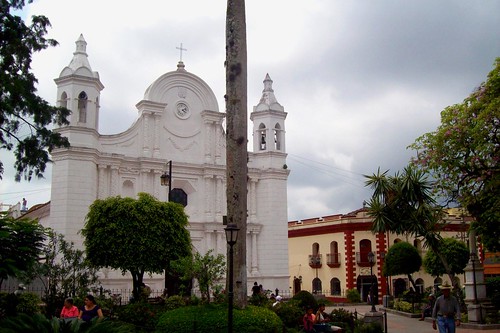 |
| Cathedral from Central Plaza, Santa Rosa de Copan |
----------
Honduras is a little less than 3 hours from main gateways in the United States by flight, with four international airports receiving daily flights from major airlines, being San Pedro Sula the main aerial entry for tourism. Getting around is easy, there is deluxe transportation service available, and private services can easily be arranged as well. There are hotels for every budget, and the locals are very friendly. English is widely spoken in Copan and Roatan and also by the staff of important hotels throughout the country.




